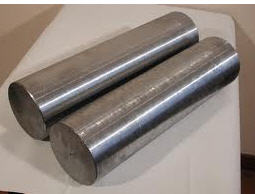Hafnium stamps

Niels Bohr in the beginning of the twentieth century was able to calculate that the last rare-earth metal must be chemical. the item below the 72-m number, the analogue of zirconium. D. de and D. Hevesi a Fire in 1923, were able to detect a new element with the properties predicted by Bohr in Greenland and Norwegian zircons. It was named from the Latin name obsolete Copenhagen — Hafnia… World production of hafnium is 70 tons per year, which is proportional to the volume of production of zirconium. The richest deposits of hafnium own South Africa and Australia. The cost of 99% purity hafnium is about 780 dollars for 1 kg.
Physical properties
Hafnium (Hf) is a severe refractory silvery-white metal. Has a densely Packed hexagonal structure of the crystal lattice with relative density for 13, 31 g/cm3. The valence +4, +3, +1, boiling point = 4603 °C, t° melting = 2233 °C. the capture cross Section for thermal neutrons is about 100 barns, which is three orders of magnitude greater than zirconium — 0.2 barns, and therefore, zirconium is used in nuclear reactors must not contain hafnium. Natural isotope 174 Hf has a weak α — activity with a half-life of 2x1015 years.
| Physical properties | |
|---|---|
| Atomic (molar) mass, g/mol | 178,49 |
| Oxidation | 4, 3, 1 |
| Density [g/cm3] | For 13, 31 |
| The melting temperature t°C | 2233°C |
| The heat of fusion kJ/mol | 25,1 |
| The thermal conductivity K [W/(m·K)] | 23 |
| Heat of evaporation kJ/mol | 575 |
Use
In nuclear power. The ability of neutron capture leads to its use in spectralite, glass, control rods Fuel rods (boride, oxide, oxicarbide, garrat lithium carbide, garret dysprosium). Alloy W-Hf-Ta is the best for fuel delivery in gas-phase nuclear engines.
In optics. Thanks to its heat-resistance and high degree of refraction HfF4 and HfO2 is used in the manufacture of multilayer x-ray astronomical mirrors, fibers for fiber optics, night vision devices.
In radio electronics. Low work function of electrons allows the hafnium cathodes high-power electron guns, vacuum tubes and thermionic generators effectively allows small work output of electrons (3,53 eV).
In electrical engineering. Along with heat resistance low electron work function makes it possible to use Hf in the manufacture of electrodes for welding in argon, especially for welding in the atmosphere CO2 mild steel, where electrodes of this type were almost four times more resistant than tungsten. It should also be noted the high economic effect of the use of alloy Ta-Hf electrodes for air-plasma and oxygen-flame cutting of metals. The alloy contains: 77% Hf, 20% Ta, 2% W, 0,5% Ag, 0.1% Of Cs, 0.4% Of Cr and in comparison with pure hafnium has nine life.
Alloys
Adding 1% Hf to aluminum gives heavy-duty alloy with a grain size of 40−50 nm. It has high tensile strength shear, torsion, tension, and also improved vibration resistance. Alloying with Hf significantly strengthens various cobalt alloys that are in demand in the petroleum industry and industrial chemistry. The boride and hafnium carbide with the melting point of 3250 °C is used as highly wear-resistant coatings, and as part of superhard alloys.
One of the most refractory materials is HfC with a melting point of 3890 °C. This alloy is indispensable in the construction of nuclear boilers gas-phase and in the production of rocket nozzles. Nickel alloy + HfB2 is used as an extremely wear-resistant composite coating. Alloy 80% TAS, and 20% HfC is considered the most heat-resistant alloy with t° melting 4216 °C.
In mechanical engineering. Titanium alloys doped with hafnium are used in the manufacture of parts for marine engines. Alloying hafnium Nickel improves corrosion resistance and strength, and also strengthens the weld seam and improves the weldability. The addition of Hf to the tantalum dramatically increases the resistance to air oxidation due to the formation of protective film of complex oxides on the surface, very resistant to thermal shock. This has resulted in indispensable in today alloys for the rocket industry (gas nozzles, rudders, which contain up to 20% Hf).
Other applications
Alloys with rare earth elements such as terbium, samarium — used for heavy duty permanent magnets. Dielectrics with high permittivity on the basis of the HfO2 come in microelectronics to replace classical silicon oxide, allowing you to achieve a much greater information density. As the dielectric with high dielectric permeability there is also known a silicide of hafnium. Alloys with scandium is used in microelectronics in order to obtain resistive films with exceptional properties.
| Chemical composition, in percentages. | |||||||
|---|---|---|---|---|---|---|---|
| Mark | Standards for levels of impurities, not higher | ||||||
| Carbon | Nitrogen | Oxygen | Silicon | Cubic Zirconia | Iron | ||
| GFI-1 | 0,03 | 0,015 | 0,03 | 0,02 | 1,0 | 0,05 | |
Promising areas of use
Hf-178m2 is a byproduct of nuclear energy (nuclear power plants — absorbing exhaust hafnium rods). This isotope has a half-life of 31 g contains an excess of energy release that is possible with the aid of radiation of the nucleus. The energy that is contained in one gram of Hf-178m2 same 50 kg of TNT, making it possible to use it in order to «pump» the compact combat lasers and as a controlled source of gamma rays, for example, in radiography or as a capacious source of energy for transport.
Buy at best price
In stock LLC «AVEK global» — the widest range of rare and refractory metals at the best prices. Our specialists are ready to answer any questions and to help in the selection of necessary materials, upon request, will provide all the necessary information about the product, cost and delivery time. Rates depend on scope of delivery and additional conditions. For wholesale orders discounts. Buying products of the company «AVEK global», You will find a worthy partner.


